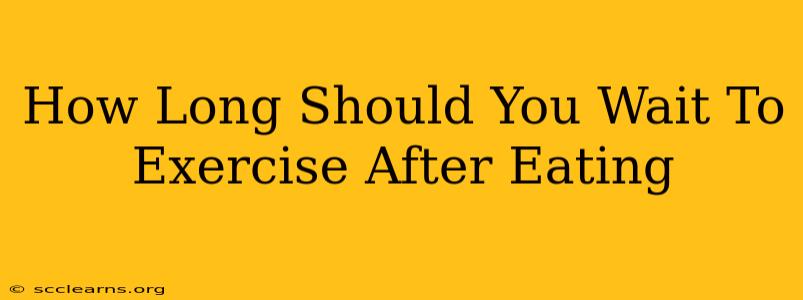The question of how long to wait before exercising after eating is a common one, and the answer isn't a simple one-size-fits-all. It depends on several factors, including the type and size of your meal, your fitness level, and the intensity of your workout. Let's delve into the details to help you find the optimal time for your fitness routine.
Understanding the Digestive Process and Exercise
When you eat, your body diverts blood flow to your digestive system to aid in the breakdown and absorption of nutrients. This means there's less blood available for your muscles during exercise. If you exercise too soon after a large meal, you might experience:
- Digestive discomfort: This can range from mild bloating and cramping to more serious issues like nausea and vomiting.
- Reduced performance: The decreased blood flow to your muscles can lead to fatigue and reduced athletic performance.
- Increased risk of side stitches: A common experience when exercising soon after eating, particularly with high-intensity activities.
How Long Should You Wait? A General Guideline
While there's no magic number, a general guideline is to wait at least 30 to 60 minutes after a light meal or snack before engaging in moderate-intensity exercise. For heavier meals, waiting 2-3 hours is often recommended.
However, several factors modify this guideline:
1. Type of Meal
- Light snacks: Small, easily digestible snacks like a banana or a small handful of nuts might only require a 15-20 minute wait before a light workout.
- Moderate meals: A moderate-sized meal consisting of lean protein, complex carbohydrates, and healthy fats will generally require a 30-60 minute wait.
- Large, heavy meals: Large meals, especially those high in fat, require a longer wait of 2-3 hours or even longer to avoid discomfort.
2. Intensity of Exercise
- Low-intensity exercise: For activities like walking or gentle yoga, you may be able to exercise sooner after eating than with more strenuous activities.
- High-intensity exercise: Intense workouts like running sprints or weightlifting demand more blood flow to the muscles, so a longer wait is recommended.
3. Individual Factors
- Fitness level: Highly trained athletes may be able to tolerate exercise sooner after eating than less fit individuals.
- Individual sensitivity: Some individuals are more sensitive to exercising after eating than others. Pay attention to your body's signals.
What to do if you experience discomfort?
If you experience any digestive discomfort during or after exercise, stop immediately and rest. Listen to your body and adjust your pre-workout meal timing accordingly.
Optimizing Your Pre-Workout Nutrition
Planning your meals and snacks strategically is crucial for optimal performance and to avoid discomfort. Consider:
- Smaller, frequent meals: This approach helps to maintain blood sugar levels and prevent blood sugar spikes.
- Easily digestible foods: Focus on foods that are easy to digest, such as fruits, vegetables, lean protein, and whole grains.
- Hydration: Staying well-hydrated is essential for both digestion and exercise.
Conclusion: Listen to Your Body
Ultimately, the best way to determine how long you should wait to exercise after eating is to pay close attention to your body. Experiment with different waiting periods to find what works best for you, taking into account the factors discussed above. If you experience discomfort, adjust your approach. Prioritize listening to your body's cues for optimal health and performance.

